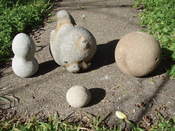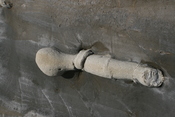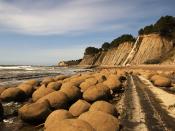Dating back to the 18th century concretions have been known as geologic curiosity's due to the various sizes, shapes and compositions. Concretions have also been thought to be dinosaur eggs, extra-terrestrial debris, human artifacts and animal and plant fossils. Due to these curiosity's I will try and enlighten you more on these in the following by explaining the process in which they are formed and explaining some locations where they can be found in large outcrops.
"The word "concretion" is derived from the Latin "con"-- meaning "together" -- and "cresco" -- meaning "to grow."" Concretions are hard compact accumulations of mineral matter and are found inside sedimentary rocks. Some examples of this are Sandstone and in some weathered volcanic rock. Concretions come in many different shapes and the most common of the shapes is spherical or disk shaped. Concretions are the most varied-shaped rocks of the sedimentary world. The way concretions come to be is the mineral matter concentrates around the nucleus of a host rock.
The nucleus is often organic such as a tooth or leaf or shell or fossil. As the mineral matter concentrates around the nucleus it forms harder zones known as nodules.
Concretions are very odd in the sense that they very in size, shape, color and hardness. Often concretions are mistaken for bones, fossils, meteorites and other odd objects. They can be so small that it requires a magnifying glass to be visible or as large as 10 feet in diameter and weigh hundreds of pounds. Concretions can also have somewhat of regular shapes such as boxes, blocks, flat disks, pipes, cannon balls and have even been known to resemble parts of a human body such as a foot or ribs.
Concretions are most commonly composed of calcite but sometimes can be composed of iron...


